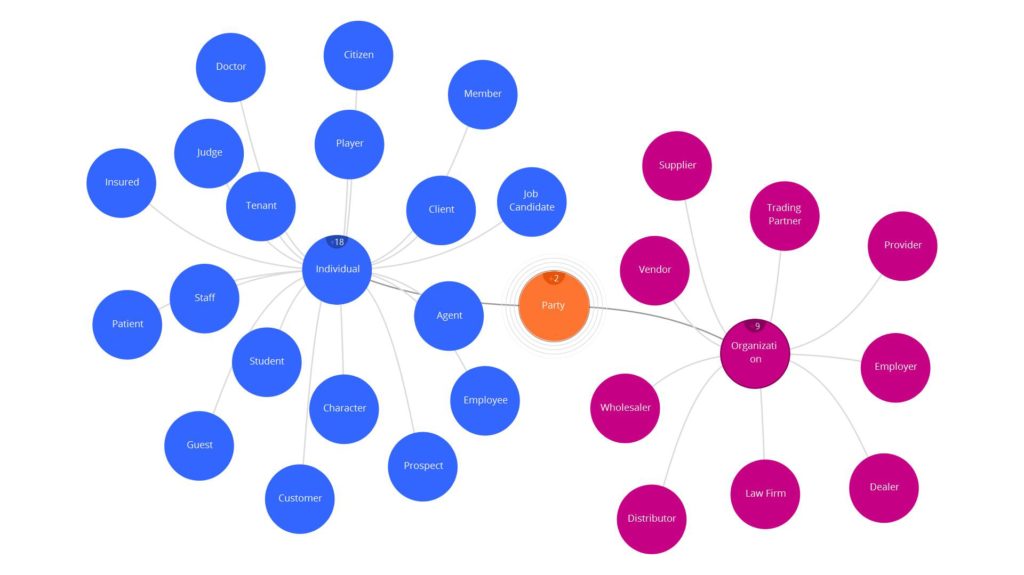
Party Data Model in Master Data Management
Many MDM initiatives center around customer data. A standard definition used in the industry is “Party” and “Party Domain” is a shared phrase used amongst MDM practitioners. Data model design around party domain is a critical area to address during MDM. In this blog, I share my observations and suggest best practices.
Party usually has two subtypes – person and organization. Person and organization parties have many characteristics in common:
- They both have one or more names.
- A person has an official name, nickname, alias and/or pseudonym.
- An organization has a legal name, trade names and/or trademarks.
- They have one or more internal or external identifiers.
- Social Security Number (SSN) is a 10-digit identifier in the US for individuals.
- Employer Identification Number (EIN) or Federal Tax Identification Number is used to identify a business entity. It can also be DUNS number supplied by Dun & Bradstreet
- They usually have an associated location (shared among parties).
- They have a communication method which can be a phone number, email address; Twitter handles and more.
One of the important factor to consider during an MDM tool selection process is the flexibility offered by the tool to support different ways in which we identify a Party. I have seen various names used to refer a Party in the data model. The usage depends on the industry and the use case. Ex: Customer versus Prospect in a marketing analytics use case.
I would like to list few variations I have seen while working with customers
- Person: Customer, Patient, Doctor, Member, Citizen, Client, Person, Signer, Authorizer, Insured, Agent, Character, Prospect, Student, Contact, Guest, Staff, Licensee, Tenant, Lessee, Player, Counter Party, Employee, Employer, Job Candidate, Judge, Owner, Death Master
- Organization: Wholesaler, Distributor, Dealer, Organization, Trading Partner, Law Firm, Vendor, Supplier

MDMGeek’s Point of View:
MDM adoption is a huge challenge because it brings change to the way you manage your most critical data assets. It is important that we take these variations into consideration while implementing an MDM solution. You should look for a vendor tool that provides you the data model flexibility to define YOUR master data the way YOU call it – not how vendor suggests you to do.
You may have come across more ways Party is known. I love to hear your comments. Send me any feedback you have via comments. You can also reach me at @mdmgeek.
Also check out insights from @axeltroike, @hlsdk, @murnane and others in my Twitter community on the ideas related to data modeling.
COMMENTS
Leave A Comment
RECENT POSTS

Composable Applications Explained: What They Are and Why They Matter
Composable applications are customized solutions created using modular services as the building blocks. Like how...

Is ChatGPT a Preview to the Future of Astounding AI Innovations?
By now, you’ve probably heard about ChatGPT. If you haven’t kept up all the latest...

How MDM Can Help Find Jobs, Provide Better Care, and Deliver Unique Shopping Experiences
Industrial data is doubling roughly every two years. In 2021, industries created, captured, copied, and...
Good stuff Prash and thanks a lot for the mention. A few opinions from my side:
• I prefer to keep MDM data models as close to the real world as possible. This is not because you should try to mimic the real world, but because encompassing multiple purposes of use (which is the end goal for MDM) will work best with a real world aligned approach.
• International use of the same model is a challenge. The concept of a national ID like the US SSN and EIN is common, but where the ID have different strengths around the world. Location format is a good old chestnut too. Name formats as well.
Hey Prash,
I also want to thank you for the “shout out”, I enjoy reading your work very much!
I’ve spent almost an entire career thinking about the PERSON (Individual) PARTY model and every time I think I’ve got the perfect idea “things happen” and I go back to the beginning, so I can firmly agree with you on the need for flexibility. I often shift my thinking from full blown models to simple registries, which I suppose is good and bad. Good because I’m flexible and likely trying to meet the immediate and strategic business objectives. Bad because I’m not doing “cookie cutter” solutions which could be implemented quickly.
Henrik has a good point about the internationalization as well, I often see international records in data sets where I was only supposed to see U.S. records.
All the best…Rich
Hi Prash,
Great Stuff.. What are your thoughts on using the Party Role in MDM? What complications do you see in using ‘role’ such as ’employee’, ‘customer’ instead of party type?
Thanks!!
Sasi
Great Stuff Prash. I’m missing “Sole Trader” in your Chart – where would you position Sole Trader due to the fact that it is both individual and legal entity (organization) ? best Robert
Hi Prash,
Great points!
Other than what you’ve highlighted, below are some key callouts I believe should be considered:
– Relationships amongst party (both Individual and Organization) as it is a critical factor from the model flexibility perspective
– Model should be able to provide lifecycle insights of a party (i.e. Prospect to Customer, or, Supplier to Customer) based on the interactions with the organization
What are your thoughts on Party Relationships, which is important to derive Unified Customer View or Customer 360 insights?
Thanks,
Achal
Hi Prash,
You raise important points that should be considered before implementing any Master Data Management solution.
Still, it’s definitely worth to revisit the topic of Master Data Management from time to time as perspectives evolve from project to project.
(Other) recurring questions are: What is a subtype, what is a role of Party? What are the (different) roles of a (same) subtype? What is just another name for the same subtype or role? Which subtypes or roles are non-exclusive relationships?
Answers to these questions may depend on your business, but also how related Parties see your business.
And Thanks again for the mention.
Best, Axel